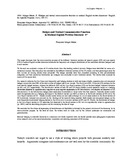Mostrar el registro sencillo del ítem
Hedges and textual communicative function in medical english written discourse
| dc.rights.license | http://creativecommons.org/licenses/by-nc-sa/3.0/ve/ | |
| dc.contributor.author | Salager-Meyer, Françoise E. | |
| dc.date.accessioned | 2009-04-14T19:31:10Z | |
| dc.date.available | 2009-04-14T19:31:10Z | |
| dc.date.issued | 1994 | |
| dc.identifier.uri | http://www.saber.ula.ve/handle/123456789/27713 | |
| dc.description.abstract | This paper discusses how the communicative purpose of the different rhetorical sections of research papers (RP) and case reports (CR) in medical English written discourse influences the frequency and category distribution of the modulation devices (hedges) used in each section. To this end, we analyzed a corpus of 15 articles drawn from five leading medical journals. Hedges were identified by means of a contextual analysis, their frequency was recorded in the different rhetorical sections of the 15 articles, and their percentages (over the total number of running words) were computed. The hedges recorded were then classified according to five pre-established categories, and their percentual distribution per category was evaluated in each rhetorical section. The results were analyzed by means of Chi-square tests. Our research indicates that the three most frequently used hedging devices in both text-types (shields, approximators and compound hedges) account for over 90% of the total number of hedges used in our sample. The Discussion (RP) /Comment (CR) sections are the most heavily hedged sections, whereas the Methods (RP) and the Case Report sections (CR) are the least-hedged rhetorical divisions (p=.001 and .071 respectively). The Introduction section of both RP and CR favors shields (mainly epistemic verbs) as a hedging convention followed by approximators (negative or quasi negative expressions in RP Introductions, and adaptors of frequency in CR Introductions). In the Introduction hedges allow researchers to establish an "early niche" for their research. Scientific writers mostly resort to approximators as a hedging technique in the Methods section (p=.0001) as well as in the Results sections of RP and in the Case Report sections of CR. Shields (mostly modal verbs) are also used (although to a much lesser extent) in the Result section of RP to evaluate, interpret and comment on the findings of the research being reported. Both shields and compound-hedges are the most frequently encountered hedging devices in the Discussion/Comments sections of RP and CR. Finally, the distribution of hedges in the Case Report section in CR resembles that observed in the Result section in RP, but it is significantly richer in approximators (p= .0001) used for describing symptoms and for conveying the idea of range. We conclude that the choice of expressions of tentativeness and flexibility is dictated by the general structure of the discourse, by its communicative purpose, by the level of claim the writers wish to make, and by the authors' pretension to universality and generalization. Because hedging in scientific discourse is a necessary and vitally important skill, we finally provide some pedagogical implications of our research such as the use of sensitization, translation and rewriting exercises in ESP courses. | es_VE |
| dc.language.iso | en | es_VE |
| dc.publisher | English for Specific Purposes. 13(2), 149-171 | es_VE |
| dc.rights | info:eu-repo/semantics/openAccess | |
| dc.title | Hedges and textual communicative function in medical english written discourse | es_VE |
| dc.type | info:eu-repo/semantics/article | |
| dc.description.colacion | 149-171 | es_VE |
| dc.description.email | frmeyer@cantv.net | es_VE |
| dc.subject.facultad | Facultad de Humanidades y Educación | es_VE |
| dc.subject.thematiccategory | Artes y Humanidades | es_VE |
| dc.subject.tipo | Artículos | es_VE |
| dc.subject.unidadinv | Grupo de Investigación Multidisciplinario del Análisis del Discurso Científico | es_VE |
| dc.type.media | Texto | es_VE |


